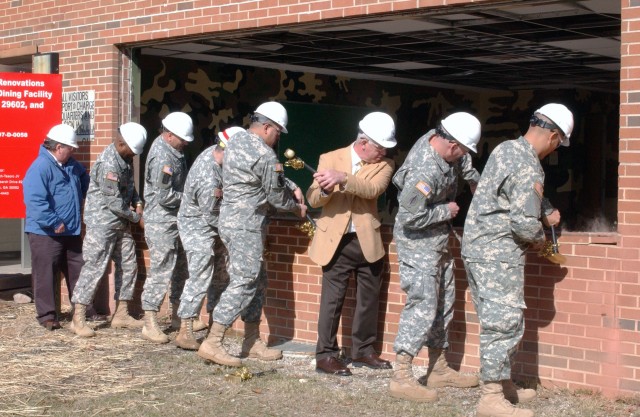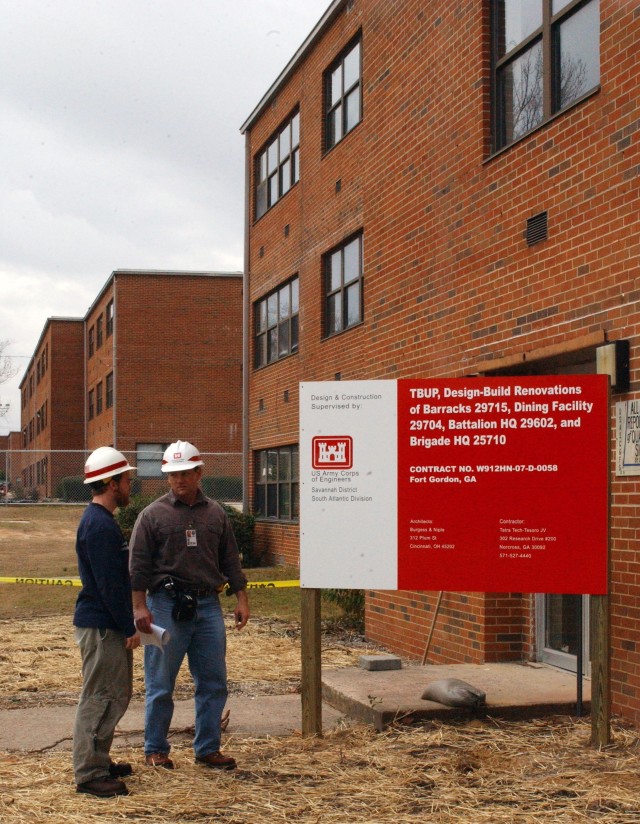The Army's home of the Signal Corps and information technology is receiving a facelift with the Gordon Trainee Barracks Upgrade Project which will renovate 35 buildings.
The project began Jan. 23 with a "demolition ceremony" by the Savannah District of the Corps of Engineers for the first of the 35 buildings.
The project will renovate 40-year-old barracks and supporting buildings and extend their life by 25 years to provide standard quarters for Advanced Individual Training Soldiers. Plans call for completing the upgrades by 2015.
"This is a long overdue project," said Fort Gordon Garrison Commander, Col. John Holwick said. "The vast majority of my installation is trainees. Over 4,000 roll through here each year. These [buildings] were state-of-the-art [when they were built], but they've started to fail. We decided that we had to extend the life of these, to bring them up to 2008 standards. They say this will extend the life 25 years, but I think it will be closer to 40 - these are sound structures."
The entirety of the Savannah District-run project includes the upgrade of 18 barracks, one brigade headquarters building, four battalion headquarters buildings, four dining facilities and eight company administration buildings. The buildings will be gutted to the shell to try to keep as much of the structural integrity of the buildings as possible, which is a less expensive alternative to a complete rebuild.
The current phase, to be completed in February 2009, includes the renovation of one barracks building, one dining facility, one battalion headquarters and the 15th Signal brigade headquarters, with a total cost of $17,084,000 for the four buildings.
Savannah District officials awarded the four-building contract Tetra-Tech, out of Atlanta, in September. It contains the "potential for awarding future projects," according to Gary Wilder, Fort Gordon project engineer.
The first step in the current project is demolishing, to steel and concrete, the first barracks building, and rebuilding a 40,645 square foot, three-story barracks.
"We are doing this to provide adequate living spaces that meet new Army standards," said Fort Gordon resident engineer Phill Payne. "We are making sure that entry level Soldiers get a good introduction into the Army."
In the old buildings, Soldiers most often complained of the lack of showers, and the lack of modern amenities. The new barracks will consist of two-person suites with a bathroom in each, a new and modern air conditioning system, plumbing and electrical upgrades, and a computer lab. It will also include the addition of an exterior walkway to the second and third floors, with all rooms having exterior access.
"Sometimes you have to wait a half hour for the shower," said Private 1st Class Edgardo Camacho, of the 15th Signal Battalion. "These new barracks will be more comfortable, that's the most important thing. I think it will just help [troop] morale."
"The Army is a world-class organization, therefore our Soldiers should be living in world-class facilities," said Lt. Col. Steve Middleton, Deputy Brigade Commander, 15th Regimental Signal Brigade. "When you recruit new Soldiers into the Army, you want them to have the newest equipment, training, and facilities. This will help to achieve that."
All design specifications for the renovations must meet the silver level of LEED (Leadership in Energy and Environmental Design), an Army-wide mandate. Structures must be built to reduce waste sent to landfills, conserve energy and water, reduce harmful greenhouse gas emissions, be healthier and safer for occupants, and incorporate sustainable design features.
"Fiscal year 2008 mandates that we now design and build to meet those standards," Payne said. "There is a cost to it; it impacts the upfront cost, but it is supposed to be more cost-effective in the long run [by reducing energy waste]."
The price tag for the eight-year project is $365 million.
"It's going to change the whole look of Fort Gordon," Holwick said. "We're the home of technology for the Army, for the whole military, so we have to give the look of a world-class post, and this should do it."
<i>(This article is part of a series on how the Army's largest military construction program since World War II affects military installations. For more information on MILCON, see the March issue of Soldiers magazine.)</i>




Social Sharing